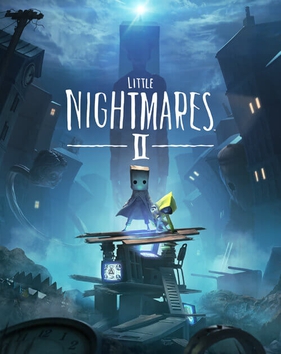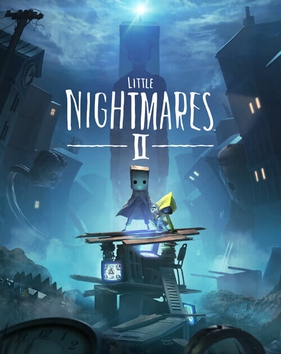
A gentle breeze wallows across the grassy plain as the dim moonlight illuminates a dark forest scattered with old-timey television sets. The twilight follows me as I explore the landscape of overgrown roots and earth, continuing to shuffle through the underbrush. Nothing pops out besides a lone shoe or sporadic bursts of wind. Yet as I continue through the panoramic landscape, the buzzing of flies and creaking of hung rope alerts me of the grotesque bodies overhead, thrusting me into a true nightmare.
Little Nightmares II, a horror-adventure game sequel to Little Nightmares I, was released on Feb. 11. The game follows Mono, a boy battling his way through various levels to stop the mysterious “distortion” plaguing the Little Nightmare world. The game maintains a side-scrolling, platformer-like style, and although going through stages might take time, there isn’t a steep learning curve for most novice players. The game introduces a pseudo-combat system where the player can use objects such as wrenches or hammers to smash the sub-villains. However, the 2.5 dimensional system of the game, meaning that the player mainly travels in a horizontal fashion while observing 3D objects, was frustrating at times. The lack of vertical perception meant missing enemies by an inch or two and having to restart from the checkpoint. Although the game did a lot right with its level design, meticulous, frame-by-frame accuracy became marginally irritating.
“Little Nightmares’ playful innocence captured a flourishing story in addition to the fear-inducing moments”
The game is also specified as a puzzle adventurer. The “puzzles” were niche, and I found myself scouring YouTube videos after trying almost everything. Don’t expect a brain teaser or logical puzzle when getting into the game, but more of a manipulation of certain aspects of the levels.
I initially expected Little Nightmares II to resemble many other games already out there. However, this game carries a certain uniqueness that you won’t find in many others, especially those horror related. While most other titles use jump scares or a first-person view to try to frighten the player, Little Nightmares’ playful innocence captured a flourishing story in addition to the fear-inducing moments. Moreover, playing as a small child in a big scary world furthers the trope of wading through the great unknown.
The addition of Six, Mono’s companion, acts as a pillar of humanity and assurance during the playthrough. Although Six is controlled by the game’s artificial intelligence, she ends up building a lasting impact towards the story, sometimes being instrumental to the player’s progression.

While I found the left-to-right aspect of the game slightly irritating, it was a huge addition to the mystifying nature. Moving from one doorway to another created uncertainty that truly made the game feel like a horror piece. The player never knows what to expect when advancing into a new room, whether that be just another hallway or a dismembered body part. I found myself squinting my eyes at times where I heard strange noises, wanting to drop my controller right before the camera panned over to what lay in the adjoining area. The game became a battle of fear and curiosity as I grappled with stopping and taking a few breaths or continuing on.
The game isn’t defined by horror, however. The art style and direction left a lasting impact throughout and added to the ambiance. Many horror games strive for realism, but the animated characteristics of Little Nightmares II drew me into the game in general. Distorted world-design created a lasting obscurity towards the writers’ intents, and progression into the story developed this unspoken narrative.
“The players’ actions and progression are foundational to the lore and the storyline”
From beginning to end, there is little to no guidance of where to go or what to do, making Little Nightmares feel less like a video game and more like a stellar feature. The players’ actions and progression are foundational to the lore and the storyline, not the voice of a narrator. Overall, the game did great with immersing and engaging the player. Even if the game did get terrifying, the fear-factor kept me glued to my screen wanting to discover the next piece of plot in the storyline. The development throughout is entirely worth the play, although the game has a single storyline without much replayability. Furthermore, compared to many other large titles, the playthrough is only around seven to eight hours in length, depending on the player. That being said, the unexpected ending brings even more questions and had me fixated on finding answers.
Although I don’t usually gravitate towards the horror genre, Little Nightmares II is a game for those who love horror and those who may not alike. The mix of fear and artistic direction allows the game to be something more than just a horror game. The game delivers a single-hit experience that has merit in its ability to both frighten and entrance the player.



